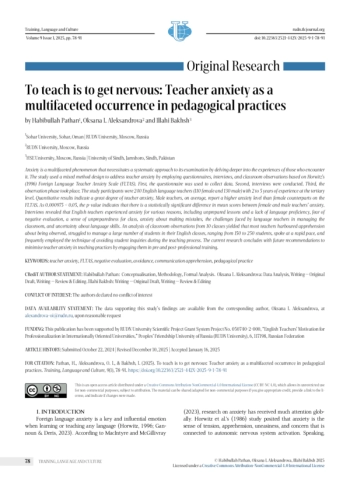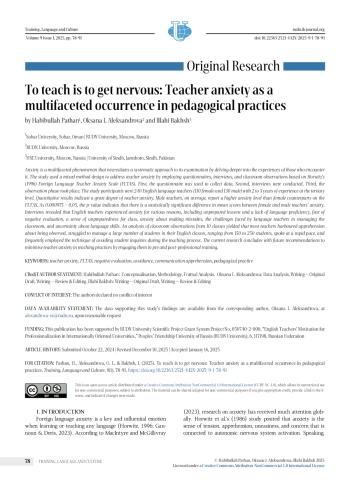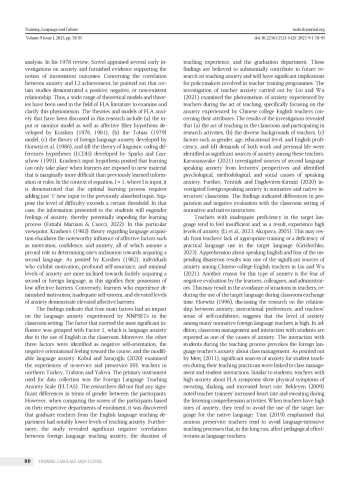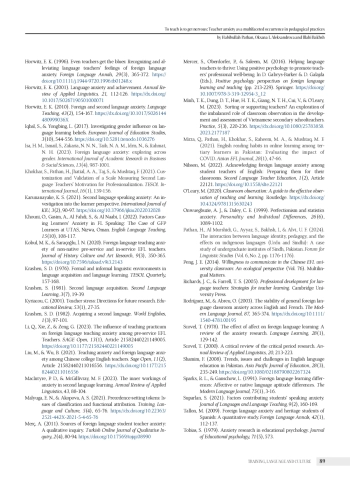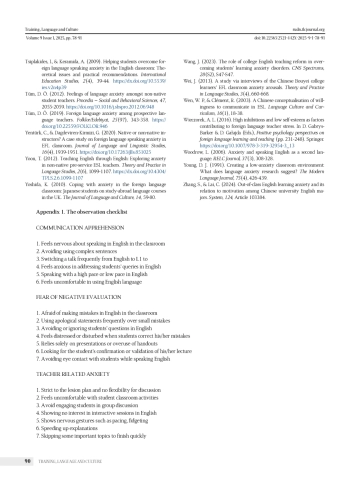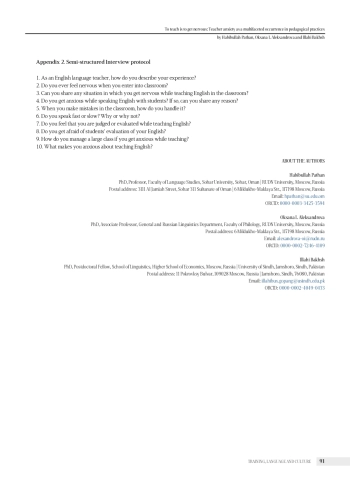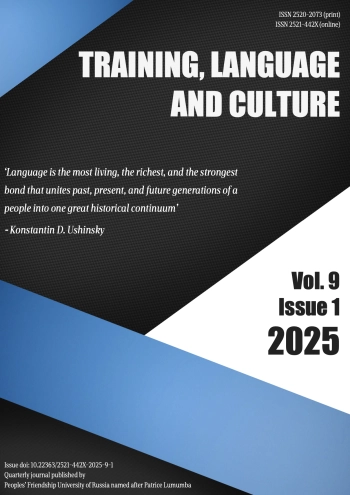Anxiety is a multifaceted phenomenon that necessitates a systematic approach to its examination by delving deeper into the experiences of those who encounter it. The study used a mixed method design to address teacher anxiety by employing questionnaires, interviews, and classroom observations based on Horwitz’s (1996) Foreign Language Teacher Anxiety Scale (FLTAS). First, the questionnaire was used to collect data. Second, interviews were conducted. Third, the observation phase took place. The study participants were 240 English language teachers (110 female and 130 male) with 2 to 5 years of experience at the tertiary level. Quantitative results indicate a great degree of teacher anxiety. Male teachers, on average, report a higher anxiety level than female counterparts on the FLTAS. As 0.000975 < 0.05, the p-value indicates that there is a statistically significant difference in mean scores between female and male teachers’ anxiety. Interviews revealed that English teachers experienced anxiety for various reasons, including unprepared lessons and a lack of language proficiency, fear of negative evaluation, a sense of unpreparedness for class, anxiety about making mistakes, the challenges faced by language teachers in managing the classroom, and uncertainty about language skills. An analysis of classroom observations from 10 classes yielded that most teachers harboured apprehension about being observed, struggled to manage a large number of students in their English classes, ranging from 150 to 250 students, spoke at a rapid pace, and frequently employed the technique of avoiding student inquiries during the teaching process. The current research concludes with future recommendations to minimise teacher anxiety in teaching practices by engaging them in pre and post-professional training.
Идентификаторы и классификаторы
Foreign language anxiety is a key and influential emotion when learning or teaching any language (Horwitz, 1996; Gannoun & Deris, 2023).
Список литературы
1. Agapova, E. A., & Grishechko, E. G. (2016). Censorship as a factor of information warfare. Russian Linguistic Bulletin, 3(7), 43-44. DOI: 10.18454/RULB.7.06 EDN: XRZCBV
2. Aida, Y. (1994). Examination of Horwitz, Horwitz, and Cope’s construct of foreign language anxiety: The case of students of Japanese. The Modern Language Journal, 78(2), 155-168. DOI: 10.1111/J.1540-4781.1994.TB02026.X
3. Akopova, A. S. (2005). Preparation of master’s students of the humanities faculties of the university for research activities in a foreign language course. RGPU Press. EDN: NIETLT
4. Aydin, S., & Ustuk, Ö. (2020). A descriptive study on foreign language teaching anxiety. International Online Journal of Education and Teaching, 7(3), 860-876.
5. Bekleyen, N. (2009). Helping teachers become better English students: Causes, effects, and coping strategies for foreign language listening anxiety. System, 37(4), 664-675. DOI: 10.1016/j.system.2009.09.010
6. Bilali, O., & Tarusha, F. (2015). Factors influencing the appearance of teaching anxiety to student teachers. European Journal of Social Science Education and Research, 2(2), 90-94. DOI: 10.26417/EJSER.V3I2.P90-94
7. Braun, V., & Clarke, V. (2006). Using thematic analysis in psychology. Qualitative Research in Psychology, 3(2), 77-101. DOI: 10.1191/1478088706qp063oa
8. Bux, I., Memon, R. A., Sartaj, S., Bhatti, J., Gopang, A. S., & Angaria, N. M. (2019). Classroom sources of English language anxiety: a study of fresh engineering students at Mehran UET, Pakistan. International Journal of English Linguistics, 9(2), 30-41.
9. Creswell, J. W. (2013). Research design: Qualitative, quantitative, and mixed methods approaches. Sage Publications.
10. Fattahi Marnani, P., & Cuocci, S. (2022). Foreign language anxiety: A review on theories, causes, consequences and implications for educators. Journal of English Learner Education, 14(2), 2.
11. Fraschini, N., & Park, H. (2021). Anxiety in language teachers: Exploring the variety of perceptions with Q methodology. Foreign Language Annals, 54(2), 341-364. DOI: 10.1111/flan.12527 EDN: NAXEBU
12. Fraschini, N., & Park, H. (2022). A Q methodology study to explore Korean as a second language undergraduate student-teacher anxiety. International Journal of Educational Research Open, 3, Article 100132. DOI: 10.1016/j.ijedro.2022.100132
13. Gannoun, H., & Deris, F. D. (2023). Teaching anxiety in foreign language classroom: A review of literature. Arab World English Journal, 14(1), 379-393. DOI: 10.31235/osf.io/8jfge EDN: QSZPFY
14. Gannoun, H., Kunt, N., & Deris, F. D. (2023). Investigating anxiety about teaching a foreign language among EFL teachers pursuing their postgraduate studies. Issues in Language Studies, 12(1), 39-54. DOI: 10.33736/ils.5101.2023 EDN: TEEADA
15. Gillham, B. (2000). The research interview. Continuum.
16. Goetze, J. (2023). Like student like teacher? Taking a closer look at language teacher anxiety. Annual Review of Applied Linguistics, 43, 41-55. DOI: 10.1017/s0267190523000053 EDN: LSHUYM
17. Gopang, I. B., Ansari, S., Kulsoom, U., & Laghari, A. (2017). An empirical investigation of foreign language anxiety in Pakistani university. International Journal of English Linguistics, 7(2), 21-31. DOI: 10.5539/ijel.v7n2p21
18. Gregersen, T., & Horwitz, E. K. (2002). Language learning and perfectionism: Anxious and non-anxious language learners’ reactions to their own oral performance. The Modern Language Journal, 86(4), 562-570. DOI: 10.1111/1540-4781.00161
19. Grishechko, E. G. (2023). Enhancing language learning with podcasts: Evidence from feedback and practice. In Topical Issues of Linguistics and Teaching Methods in Business and Professional Communication (pp. 69-72). Academ-Lit. EDN: DJONAB
20. Horwitz, E. K., Horwitz, M. B., & Cope, J. (1986). Foreign language classroom anxiety. The Modern Language Journal, 70, 725-732. DOI: 10.1111/J.1540-4781.1986.TB05256.X
21. Horwitz, E. K. (1996). Even teachers get the blues: Recognizing and alleviating language teachers’ feelings of foreign language anxiety. Foreign Language Annals, 29(3), 365-372. DOI: 10.1111/j.1944-9720.1996.tb01248.x
22. Horwitz, E. K. (2001). Language anxiety and achievement. Annual Review of Applied Linguistics, 21, 112-126. DOI: 10.1017/S0267190501000071 EDN: EBYJZT
23. Horwitz, E. K. (2010). Foreign and second language anxiety. Language Teaching, 43(2), 154-167. DOI: 10.1017/S026144480999036X
24. Iqbal, S., & Yongbing, L. (2017). Investigating gender influence on language learning beliefs. European Journal of Education Studies, 3(10), 544-556. DOI: 10.5281/zenodo.1036276
25. Isa, H. M., Ismail, S., Zakaria, N. N. N., Taib, N. A. M., Idris, N., & Rahmat, N. H. (2023). Foreign language anxiety: exploring across gender. International Journal of Academic Research in Business & Social Sciences, 13(4), 987-1001.
26. Khokhar, S., Pathan, H., Jhatial, A. A., Taj, S., & Mushtaq, F. (2021). Customization and Validation of a Scale Measuring Second Language Teachers’ Motivation for Professionalization. TESOL International Journal, 16(1), 139-156. EDN: EZDAKL
27. Karunanayake, K. S. (2021). Second language speaking anxiety: An investigation into the learner perspective. International Journal of KIU, 3(2), 90-97. DOI: 10.37966/ijkiu2022032028 EDN: CZUXFX
28. Khouni, O., Gasim, A., Al Fahdi, S., & Al Naabi, I. (2022). Factors Causing Learners’ Anxiety in FL Speaking: The Case of GFP Learners at UTAS, Nizwa, Oman. English Language Teaching, 15(10), 108-117. EDN: YPGRXO
29. Kobul, M. K., & Saraçoğlu, İ. N. (2020). Foreign language teaching anxiety of non-native pre-service and in-service EFL teachers. Journal of History Culture and Art Research, 9(3), 350-365. DOI: 10.7596/taksad.v9i3.2143
30. Krashen, S. D. (1976). Formal and informal linguistic environments in language acquisition and language learning. TESOL Quarterly, 157-168.
31. Krashen, S. (1981). Second language acquisition. Second Language Learning, 3(7), 19-39.
32. Kyriacou, C. (2001). Teacher stress: Directions for future research. Educational Review, 53(1), 27-35.
33. Krashen, S. D. (1982). Acquiring a second language. World Englishes, 1(3), 97-101.
34. Li, Q., Xie, Z., & Zeng, G. (2023). The influence of teaching practicum on foreign language teaching anxiety among pre-service EFL Teachers. SAGE Open, 13(1), Article 21582440221149005. DOI: 10.1177/21582440221149005
35. Liu, M., & Wu, B. (2021). Teaching anxiety and foreign language anxiety among Chinese college English teachers. Sage Open, 11(2), Article 21582440211016556. DOI: 10.1177/21582440211016556
36. MacIntyre, P. D., & McGillivray, M. F. (2023). The inner workings of anxiety in second language learning. Annual Review of Applied Linguistics, 43, 88-104. EDN: OVUYSV
37. Malyuga, E. N., & Akopova, A. S. (2021). Precedence-setting tokens: Issues of classification and functional attribution. Training, Language and Culture, 5(4), 65-76. DOI: 10.22363/2521-442X-2021-5-4-65-76 EDN: SNFBNY
38. Merç, A. (2011). Sources of foreign language student teacher anxiety: A qualitative inquiry. Turkish Online Journal of Qualitative Inquiry, 2(4), 80-94. DOI: 10.17569/tojqi.08990
39. Mercer, S., Oberdorfer, P., & Saleem, M. (2016). Helping language teachers to thrive: Using positive psychology to promote teachers’ professional well-being. In D. Gabrys-Barker & D. Galajda (Eds.), Positive psychology perspectives on foreign language learning and teaching (pp. 213-229). Springer. DOI: 10.1007/978-3-319-32954-3_12
40. Minh, T. K., Dung, D. T., Hue, H. T. K., Giang, N. T. H., Cui, V., & O’Leary, M. (2023). Sorting or supporting teachers? An exploration of the imbalanced role of classroom observation in the development and assessment of Vietnamese secondary schoolteachers. Practice, 5(3), 220-236. DOI: 10.1080/25783858.2023.2177187
41. Mirza, Q., Pathan, H., Khokhar, S., Raheem, M. A., & Mushtaq, M. F. (2021). English reading habits in online learning among tertiary learners in Pakistan: evaluating the impact of COVID. Aisian EFL Journal, 28(1), 47-66.
42. Nilsson, M. (2022). Acknowledging foreign language anxiety among student teachers of English: Preparing them for their classrooms. Second Language Teacher Education, 1(2), Article 22121. DOI: 10.1558/slte.22121
43. O’Leary, M. (2020). Classroom observation: A guide to the effective observation of teaching and learning. Routledge. DOI: 10.4324/9781315630243
44. Onwuegbuzie, A. J., & Daley, C. E. (1999). Perfectionism and statistics anxiety. Personality and Individual Differences, 26(6), 1089-1102.
45. Pathan, H., Al Murshidi, G., Ayyaz, S., Bakhsh, I., & Alvi, U. F. (2024). The interaction between language identity, pedagogy, and the effects on indigenous languages (Urdu and Sindhi): A case study of undergraduate institutes of Sindh, Pakistan. Forum for Linguistic Studies (Vol. 6, No. 2, pp. 1176-1176). EDN: EUDJYN
46. Peng, J. E. (2014). Willingness to communicate in the Chinese EFL university classroom: An ecological perspective (Vol. 76). Multilingual Matters.
47. Richards, J. C., & Farrell, T. S. (2005). Professional development for language teachers: Strategies for teacher learning. Cambridge University Press.
48. Rodríguez, M., & Abreu, O. (2003). The stability of general foreign language classroom anxiety across English and French. The Modern Language Journal, 87, 365-374. DOI: 10.1111/1540-4781.00195 EDN: EUDEJH
49. Scovel, T. (1978). The effect of affect on foreign language learning: A review of the anxiety research. Language Learning, 28(1), 129-142.
50. Scovel, T. (2000). A critical review of the critical period research. Annual Review of Applied Linguistics, 20, 213-223.
51. Shamim, F. (2008). Trends, issues and challenges in English language education in Pakistan. Asia Pacific Journal of Education, 28(3), 235-249. DOI: 10.1080/02188790802267324
52. Sparks, R. L., & Ganschow, L. (1991). Foreign language learning differences: Affective or native language aptitude differences. The Modern Language Journal, 75(1), 3-16.
53. Suparlan, S. (2021). Factors contributing students’ speaking anxiety. Journal of Languages and Language Teaching, 9(2), 160-169. EDN: DJUARC
54. Tallon, M. (2009). Foreign language anxiety and heritage students of Spanish: A quantitative study. Foreign Language Annals, 42(1), 112-137.
55. Tobias, S. (1979). Anxiety research in educational psychology. Journal of Educational psychology, 71(5), 573.
56. Tsiplakides, I., & Keramida, A. (2009). Helping students overcome foreign language speaking anxiety in the English classroom: Theoretical issues and practical recommendations. International Education Studies, 2(4), 39-44. DOI: 10.5539/ies.v2n4p39
57. Tüm, D. Ö. (2012). Feelings of language anxiety amongst non-native student teachers. Procedia - Social and Behavioral Sciences, 47, 2055-2059. DOI: 10.1016/j.sbspro.2012.06.948
58. Tüm, D. Ö. (2019). Foreign language anxiety among prospective language teachers. Folklor/Edebiyat, 25(97), 343-358. DOI: 10.22559/FOLKLOR.946
59. Yentürk, C., & Dagdeviren-Kirmizi, G. (2020). Native or non-native instructors? A case study on foreign language speaking anxiety in EFL classroom. Journal of Language and Linguistic Studies, 16(4), 1939-1951. DOI: 10.17263/jlls.851025 EDN: FZILIL
60. Yoon, T. (2012). Teaching English through English: Exploring anxiety in non-native pre-service ESL teachers. Theory and Practice in Language Studies, 2(6), 1099-1107. DOI: 10.4304/TPLS.2.6.1099-1107
61. Yoshida, K. (2010). Coping with anxiety in the foreign language classroom: Japanese students on study-abroad language courses in the UK. The Journal of Language and Culture, 14, 59-80.
62. Wang, J. (2023). The role of college English teaching reform in overcoming students’ learning anxiety disorders. CNS Spectrums, 28(S2), S47-S47. EDN: QBVQJF
63. Wei, J. (2013). A study via interviews of the Chinese Bouyei college learners’ EFL classroom anxiety arousals. Theory and Practice in Language Studies, 3(4), 660-668.
64. Wen, W. P., & Clément, R. (2003). A Chinese conceptualisation of willingness to communicate in ESL. Language Culture and Curriculum, 16(1), 18-38.
65. Wieczorek, A. L. (2016). High inhibitions and low self-esteem as factors contributing to foreign language teacher stress. In D. Gabrys-Barker & D. Gałajda (Eds.), Positive psychology perspectives on foreign language learning and teaching (pp. 231-248). Springer. DOI: 10.1007/978-3-319-32954-3_13
66. Woodrow, L. (2006). Anxiety and speaking English as a second language. RELC Journal, 37(3), 308-328. EDN: JPGZLN
67. Young, D. J. (1991). Creating a low-anxiety classroom environment: What does language anxiety research suggest? The Modern Language Journal, 75(4), 426-439.
68. Zhang, S., & Lai, C. (2024). Out-of-class English learning anxiety and its relation to motivation among Chinese university English majors. System, 124, Article 103384.
Выпуск
Другие статьи выпуска
In a thirty-year career as a teacher of English as a foreign and second language, Nik Peachey set up his own online system for producing weekly lesson plans for teachers, focusing on social issues and addressing areas of language use of special value to language teachers wanting to introduce new topics and activities to their classes at different levels of proficiency. Like many of his colleagues, he has moved beyond the use of the computer and the Internet to produce and circulate lesson plans and now has published an online book on the role of artificial intelligence and its applications, such as ChatGPT, in language learning and teaching. Entitled The Manual of AI-Mediated Autonomous Teacher Development, the book is available online. Nik Peachey takes teachers of English through the theory and practice of artificial intelligence in a clear, simple and non-scientific approach which is adaptable to all teachers of foreign and second languages helping them create and develop new teaching materials to interest and involve their students in the learning process.
The study aims to examine how movie titles are translated from English to Vietnamese under the light of the translation methods proposed by Newmark (1988). To fulfil this research objective, the researcher uses a linguistic corpus consisting of 83 pairs of movie titles collected randomly from various sources. Two research methods are employed, including discourse analysis to analyse the linguistic components used in the original and translated titles and translation comparative to compare the linguistic and semantic similarities and differences between the two versions to identify what methods have been used in each title translation. The research findings show that of the eight methods presented by Newmark (1988), only five are employed, including faithful translation, semantic translation, idiomatic translation, free translation and adaptation, together with the two additional ones, including keeping the title unchanged and creating a new title, of which faithful translation has the highest frequency of use, while the least common method is idiomatic translation. The findings indicate that the choice of translation methods depends on the text types and translators’ consideration of the linguistic, semantic and pragmatic transfer in the translation process. These findings partly align with the earlier research of Newmark and other scholars, thereby further consolidating the theories related to translation methods while some new findings are identified as the contributions of this study to the research topic. Based on the findings, some implications have been made on how to translate movie titles in general and other text types in particular.
The evolution of musical terminology is a dynamic process influenced by historical, linguistic and social factors. While initially confined to professional discourse, musical terms have been increasingly used in non-professional contexts, necessitating further investigation into this phenomenon. This study aims to analyse the development of English musical terminology, focusing on its transformation from specialised technical vocabulary to broader cultural and communicative usage. The research employs a combination of comparative-historical analysis, textual analysis and lexicographic examination. Drawing upon sources including seminal works by Charles Ives, Charles Stanford, John Mauceri and Norman Lebrecht, the study explores how musical terms function across genres and registers. The findings reveal three primary categories of musical terms: universal, unique and author. Universal terms maintain consistent meanings across musical traditions, unique terms emerge from specific musical schools and authorial terms reflect individual creativity. The research also highlights how determinologisation and dissemination processes influence the reinterpretation of musical terms in non-professional texts. The implications of this study emphasise the dynamic role of musical terminology as a bridge between professional and non-professional communication, implying its significance in both linguistic theory and global culture. The findings contribute to a deeper understanding of terminological adaptation in evolving communicative landscapes and pave the way to further research into the role of musical terms in interdisciplinary contexts.
This study investigates the role of deictic expressions in the IELTS speaking test, addressing a gap in research on how test-takers across proficiency levels use deixis in spoken language assessment. While previous studies have examined general discourse features in language testing, little attention has been given to the frequency, functions, and distribution of deixis in assessing spoken proficiency. The study analysed a corpus of 30 IELTS speaking test transcripts, covering proficiency levels from low-intermediate to advanced. Using Levinson’s classification of deixis, the study employed quantitative frequency analysis and qualitative discourse analysis to examine variations in the use of personal, temporal, and spatial deixis. The findings revealed that personal deixis was the most frequently used, followed by temporal and spatial deixis. However, the results of One-Way ANOVA test showed no significant differences in deixis usage across proficiency levels. These findings contribute to English language teaching and assessment by highlighting how deixis functions in test-taker discourse, offering insights for IELTS preparation and speaking proficiency evaluation. The study indicates the need for further exploration of discourse features in language assessment.
English for Academic Purposes (EAP) courses in Bangladeshi private universities are positioned to equip non-native undergraduate students with the required academic language skills needed for English Medium Instruction (EMI) education. However, these courses have frequently adopted generic language proficiency models, neglecting students’ academic and disciplinary literacy needs. Moreover, the paucity of studies on EAP leaves a critical lapse in understanding what changes are required, given this misalignment. Guided by Brown’s Needs Analysis framework (2016), this qualitative study investigated non-native undergraduate students’ perceptions and experiences of EAP courses at a Bangladeshi private university offering EMI education, focusing on its method of instruction, the barriers they face and the alignment of its content with their academic and professional needs. Thematic analysis of forty-five semi-structured interviews and document analysis of EAP course syllabi revealed a misalignment between current EAP courses and students’ academic and professional needs. The development of academic writing for disciplinary courses is unfulfilled, suggesting a need for a more targeted EAP curriculum. The study identifies students’ needs as systemic failures rather than linguistic deficits and challenges the generic EAP implementation in non-native higher education contexts like Bangladesh. It concludes that context-driven curricular reform, incorporation of skill-oriented content, and enhanced pedagogic practices can make current EAP courses to be needs-responsive. Additionally, teacher training in discipline-specific pedagogy is crucial for an equitable EAP redesign as it would better align with non-native students’ academic language and professional needs.
English is the dominant medium of instruction for numerous university programmes across the Arab Gulf. While a growing body of research examines learners’ attitudes towards English Medium Instruction (EMI), issues of language preference/use have received far less attention. The research reported here sought to redress this imbalance by examining the domain-based language preferences, use, and beliefs of English majors at Oman’s national university. A mixed methods approach was employed involving the administration of a 35-item questionnaire to 120 English majors and one-on-one semi-structured interviews with 13 participants. Descriptive analysis, Pearson’s chi-squared test, and Cramer’s V test were used to examine questionnaire data, while interview transcripts were analysed thematically before data triangulation was performed. Findings indicate respondents preferred and used English for academics and intended careers, Arabic for familial interactions, and both English and Arabic or English by itself to talk about feelings and beliefs. English and Arabic were almost equally preferred for identity representation, with a significant minority of respondents expressing a desire to study their majors in Arabic. Although gender and English proficiency were not found to be related to beliefs about language importance, Arabic proficiency had a moderate, statistically significant association. Arab students employing English to express cultural beliefs and identities has not been widely reported in the existing literature. Results suggest that, despite evidence of emerging bilingualism in some domains, reform to tertiary-level language of instruction policies and planning in the region and similar contexts worldwide, including by offering Arabic Medium Instruction options, may be necessary to ensure effective education provision.
Intensifiers play a crucial role in everyday communication, varying in frequency, function, and socio-pragmatic significance across languages. However, gender-based variation in their use remains underexplored. This study examines intensifier usage among native speakers of English and Bahasa Indonesia, focusing on male and female speakers in spontaneous, face-threatening contexts. Data were collected through Elicited Oral Responses (EOR) from 40 university students – 20 English speakers from an Australian university and 20 Bahasa Indonesia speakers from a university in Jambi. Participants responded in their native language to an apologetic scenario in which a close friend had broken a promise. Their responses were recorded, transcribed, and analysed for intensifier frequency and type. Findings indicate that both language groups use intensifiers to amplify emotions and signal heightened face-threat. However, English speakers employed intensifiers more frequently and with greater variety than their Indonesian counterparts. Gender differences were also evident, with males and females differing in both the types and frequency of intensifiers used. This study contributes to sociolinguistics and pragmatics by elucidating gendered language use in intercultural communication. It also holds pedagogical implications for language learning, enhancing awareness of how intensifiers function in spoken discourse across cultures. This study contributes to cross-cultural pragmatics by examining differences in intensifier use between native English and Bahasa Indonesia speakers in face-threatening contexts. The findings enhance understanding of gender’s impact on intensifier use and supply information for language instruction, particularly in teaching emotional expressions in everyday conversations.
The present study presents a comparative analysis of the translation processes and outcomes of human translators, Neural Machine Translation (NMT) systems and Large Language Models (LLMs) focusing on the translation of Metaphor-related Words (MRW). The study employs various research methodologies, including product analysis, think-aloud protocols, subsequent interviews, and translation quality assessments to uncover the choice of strategies in translating MRWs by different subject groups as well as its relation with quality criterion. Human translators and LLMs tend to favour strategies such as metaphor into different metaphor (M-M2) and metaphor reduction (M→Non), while NMT systems prefer the reproduction of metaphors (M→M). LLMs demonstrate translation patterns which are more aligned with human translators, helping them achieve higher evaluation scores, though their performance remains inconsistent, particularly with novel metaphors. Additionally, human translators process metaphors by incorporating conceptual, cultural, and contextual factors, whereas LLMs tend to rely on paraphrastic approaches. Evaluation results indicate that LLMs exhibit proficiency on par with novice translators in terms of accuracy, idiomatic expression, and vividness in metaphor translation, while NMT systems fall slightly short. The study highlights the influence of translation strategies on the quality of metaphor translation and concludes that, while NMT systems and LLMs can achieve performance comparable to human translators, much larger metaphor-specific datasets supported studies are expected to validate its consistency.
Статистика статьи
Статистика просмотров за 2025 год.
Издательство
- Издательство
- РУДН
- Регион
- Россия, Москва
- Почтовый адрес
- 117198, г. Москва, ул. Миклухо-Маклая, д. 6
- Юр. адрес
- 117198, г Москва, Обручевский р-н, ул Миклухо-Маклая, д 6
- ФИО
- Ястребов Олег Александрович (РЕКТОР)
- E-mail адрес
- rector@rudn.ru
- Контактный телефон
- +7 (495) 4347027
- Сайт
- https://www.rudn.ru/
